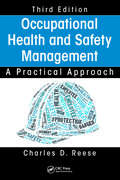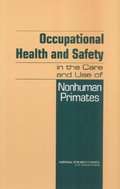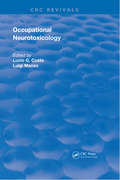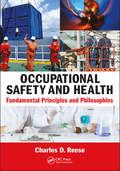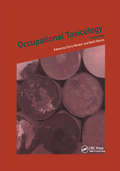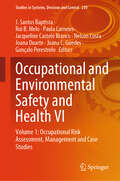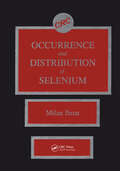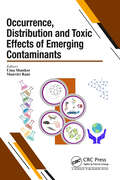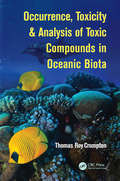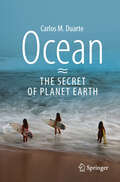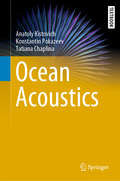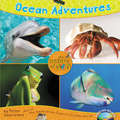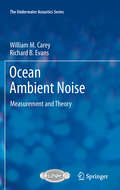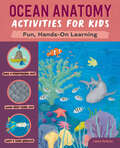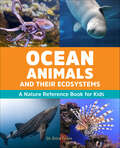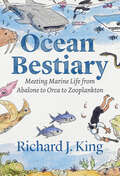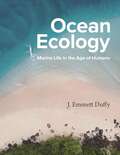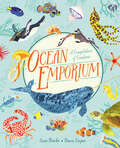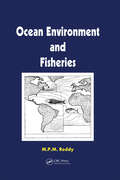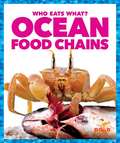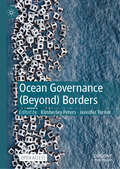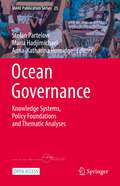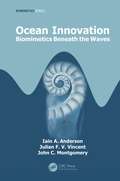- Table View
- List View
Occupational Health and Safety Management: A Practical Approach, Third Edition
by Charles D. ReeseReflecting changes in the current health and safety landscape, Occupational Health and Safety Management: A Practical Approach, Third Edition includes examples and tools to facilitate development and implementation of a safety and health management approach. This how-to book is not just an information providing text. It shows you how to write a program and identify hazards as well as involve workers and attain their cooperation. It emphasizes the need for better and more effective communication regarding safety and health.See What’s New in the Third Edition: Chapters on workers’ compensation, terrorism, and Lean safety/sustainability Additional coverage of flammable liquids and ventilation, accident reporting, and accident investigation New compliance requirements as well as expanded accident investigation, environmental, and risk analysis guidelines PowerPoint presentation slides for each chapter A complete and practical guide for the development and management of occupational safety and health programs in any industry setting, the book supplies a management blueprint that can be used for occupational safety and health in any organization, from the smallest to the largest, beginning to develop or wanting to improve its safety and health approach. It includes comprehensive guidelines for development of occupational health and safety programs to a variety of industries and is especially useful for start-up companies.The author takes a total management approach to the development of written programs, the identification of hazards, the mitigation of hazards by the use of common safety and health tools, the development of a safe workforce through communications, motivational techniques, involvement, and training. He addresses the tracking and acceptable risk from both safety and health hazards. He also discusses how to work with and within the OSHA compliance approach as well as how to deal with the OSHA regulations, workers’ compensation, terrorism, and Lean safety. As you understand and apply the guidelines in each chapter, you can put your company on the way toward building a successful and effective safety and health effort for its employers and employees.
Occupational Health and Safety in the Care and Use of Nonhuman Primates
by Committee on Occupational Health Safety in the Care Use of Nonhuman PrimatesThe field of occupational health and safety constantly changes, especially as it pertains to biomedical research. New infectious hazards are of particular importance at nonhuman-primate facilities. For example, the discovery that B virus can be transmitted via a splash on a mucous membrane raises new concerns that must be addressed, as does the discovery of the Reston strain of Ebola virus in import quarantine facilities in the U.S. The risk of such infectious hazards is best managed through a flexible and comprehensive Occupational Health and Safety Program (OHSP) that can identify and mitigate potential hazards. Occupational Health and Safety in the Care and Use of Nonhuman Primates is intended as a reference for vivarium managers, veterinarians, researchers, safety professionals, and others who are involved in developing or implementing an OHSP that deals with nonhuman primates. The book lists the important features of an OHSP and provides the tools necessary for informed decision-making in developing an optimal program that meets all particular institutional needs.
Occupational Neurotoxicology (Routledge Revivals)
by Lucio G. Costa Luigi ManzoFirst published in 1988, many chemical compounds present in workplace settings can produce a number of impairments in the human nervous system. As the situations in which neurotoxic agents have been recognized in exposed workers has grown, so has the importance of occupational neurotoxicology as a specialty. Addressing some of the most vital concerns in the field, Occupational Neurotoxicology discusses: Neurotoxic agents commonly encountered in the workplace Signs and symptoms of neurotoxicity and of the factors affecting neurotoxic effects Biological monitoring and the use of biomarkers Epidemiological methods and clinical approaches to occupational neurotoxicology The analysis of behavioral, electrophysiological, and imaging techniques in the diagnosis of neurotoxicity Occupational neurotoxicity in developing countries The evaluation and management of occupational illnesses due to neurotoxicityOccupational Neurotoxicology concisely covers important facts on the adverse effects of chemical, biological, and physical agents that can impair or alter the structure of the nervous system. Professionals and researchers in the fields of occupational medicine, toxicology, epidemiology, neurology, industrial hygiene, and psychology will all find relevant information on the health problems that can occur from exposure to neurotoxicants.
Occupational Safety and Health: Fundamental Principles and Philosophies
by Charles D. ReeseMost occupational safety and health books explain how to apply concepts, principles, elements, tools of prevention and develop interventions, and initiatives to mitigate occupational injuries, illnesses and deaths. This is not a how-to book. It is a book that addresses the philosophical basis for all of the varied components and elements needed to develop and manage a safety and health program. It is a book designed to answer the questions often posed as to why should we do it this way. It is the “Why” book and the intent is to provide a blueprint and a helpmate for the philosophical basis for occupational safety and health and the justification as an integral component of doing business.
Occupational Toxicology
by Chris Winder Neill StaceyHazardous agents are an ongoing concern in the modern workplace, with many examples of workers being severely affected by chemicals as a result of both acute and chronic exposure. Occupational Toxicology, 2nd Edition introduces the basics of toxicology that underpin the application of toxicological information to the workplace environment.
Occupational and Environmental Safety and Health VI: Volume 1: Occupational Risk Assessment, Management and Case Studies (Studies in Systems, Decision and Control #230)
by Paula Carneiro Nelson Costa Rui B. Melo Gonçalo Perestrelo J. Santos Baptista Joana Duarte Jacqueline Castelo Branco Joana C. GuedesThis book gathers cutting-edge research and best practices relating to occupational risk and safety management, healthcare, and ergonomics. It covers strategies for different industries, such as construction, chemical, and healthcare. It emphasizes challenges posed by automation, discusses solutions offered by technologies, and reports on case studies carried out in different countries. Chapters are based on selected contributions to the 21st International Symposium on Occupational Safety and Hygiene (SHO 2024), held on July 4-5, 2024, in Porto, Portugal. By reporting on different perspectives, such as the ones from managers, employees, and OSH professionals, and covering timely issues, such as implications of telework, issues related to gender inequality and applications of machine learning techniques in occupational health, this book offers extensive information and a source of inspiration to OSH researchers, practitioners, and organizations operating in both local and global contexts. This is the first volume of a 2-volume set.
Occurence & Distribution of Selenium
by Milan IhnatA comprehensive and critical assessment of selenium levels in both natural and man-made materials and systems is presented in this publication. The book begins with a treatment of the chemistry and analytical chemistry of the element and an important discussion of the status and reliability of analytical data together with the approach to be followed in extracting, managing and presenting the information. An in-depth treatment of selenium is arranged according to groupings of the different materials and systems. Each chapter discusses the occurrence of selenium in and distribution among components of the specified system. Additionally, easy reference compilations of concentration data based on critical assessment of the selenium literature are provided, along with a comprehensive listing of the pertinent literature. The book concludes with chapters on the biogeochemistry of selenium in natural systems. Throughout, consideration is given to both total selenium and its compounds.
Occurrence, Distribution and Toxic Effects of Emerging Contaminantsx
by Uma Shanker Manviri RaniEmerging contaminants include an extensive array of synthetic chemicals in global use, such as plastic additives, microplastics, water disinfection byproducts, pharmaceuticals, man-made nanomaterials, and UV-filters. Because of their extensive use in anthropogenic activities, these chemicals are entering the environment at alarming levels as hazardous wastes and non-biodegradable substances. This book emphasizes on the comprehensive information on emerging contaminants overview, environmental occurrence, analysis, risk assessment and toxicity assessment. Environmental, legal, health concerns of the ECs have also been covered in this book. The book also features an updated status from the industrial point of view.
Occurrence, Toxicity & Analysis of Toxic Compounds in Oceanic Biota
by Thomas Roy CromptonThe presence of concentrations of organic substances and cations in sea water is a matter of increasing concern to the water industry, environmentalists and the general public alike. There is a threat of possible health hazards to both human, fish and crustacea. Occurrence, Toxicity and Analysis of Marine Biota discusses bioaccumulation in biota as well as occurrence and analysis of toxicants in biota. The main thrust of this book will be a review of the levels of toxicants found in the tissues of fish and invertebrates at various sites throughout the world. In addition, results will be reported on the levels of toxicants found in marine biota enabling ill health or death to occur. This will involve a discussion of toxicity index LC50 and percentile S95 concentration of toxicants and their implications on animal health and mortality, also that of humans who eat these sea creatures. The book will be a complete logical survey of this topic.
Ocean - The Secret of Planet Earth
by Carlos M. DuarteThe ocean characterises planet Earth and differentiates it from the more than 5000 known planets. It is also the habitat where life emerged as a singularity in the universe. However, we know less about the oceans than we do about some remote planets such as Mars.This book provides basic facts for understanding the oceans, their properties and their importance to mankind through the ages. The long relationship between the ocean and humanity, which permeates all areas of our culture, is at a crossroads where human activity is profoundly affecting its functioning and the integrity of marine ecosystems. However, the intelligent and rational use of the ocean holds, in large part, the key to providing the resources needed to sustain our quality of life in the future. Unlocking, through scientific research, the secrets that the ocean still holds is an essential challenge for humanity. This book informs the reader about all these aspects of the ocean through a text that combines scientific rigour with personal reflections based on the author's own experiences, dedicated to exploring and learning more about the ocean.
Ocean Acidification
by Research Committee on the Development of an Integrated Science Strategy for Ocean Acidification Monitoring Impacts AssessmentOver recent years, human activities such as the burning of fossil fuels have increased the amount of carbon dioxide gas emitted to the atmosphere--and the amount that dissolves into the ocean. Now, so much carbon dioxide has been absorbed by the ocean that the chemistry of seawater is changing, causing the ocean to become more acidic. Based on a National Research Council report, this booklet describes the well-understood chemistry of ocean acidification and explores the many questions that remain: How will ocean acidification impact marine life such as fish, corals, and shellfish? How will the effects on individual species scale up to whole ecosystems? What will ocean acidification mean for aquaculture, the fishing industry, and coastal tourism?
Ocean Acoustics (Springer Textbooks in Earth Sciences, Geography and Environment)
by Konstantin Pokazeev Anatoly Kistovich Tatiana ChaplinaThis book presents a comprehensive overview of hydroacoustics and describes the physical basis of acoustic processes observed in the sea. In addition, it discusses the basic concepts and provides simplified models of sound propagation and acoustic phenomena at the boundary between environments. Lastly, the book examines in detail a number of applications of ocean acoustics and methods. The ocean is the last reserve of natural resources. It is also an essential element in the biosphere, ensuring the latter’s balance, and plays a pivotal role in the Earth’s climate system and global warming. Consequently, studying the ocean is one of humankind’s most critical scientific tasks, but penetrating its mysteries is no mean feat. Acoustics (hydroacoustics) is one of the most powerful tools for examining the water layer and beyond, since sound waves are the only type of radiation that can propagate over distances of hundreds and even thousands of kilometers in the ocean.This unique resource appeals to specialists working in the fields of ocean and atmosphere physics, students and postgraduate students studying sea physics and oceanology, and anyone who is interested in the problems the ocean is currently facing.
Ocean Adventures
by Peter SchriemerThese two titles have content based upon and supplementing the lessons about God’s creation that are found on the Nature of God DVD collection by Peter Schriemer. These titles, with facts and photos of Hawaii and the Great Lakes habitats and creatures will enrich the lessons taught by Schriemer or can stand alone as informational and fun resources for young readers and their families. The addition of the DVDs showing clips from the Nature of God DVD collections with each book is sure to be a draw for families that are looking for ways to enrich their children’s knowledge of science and nature as well as show, in a beautiful and visual way, that nature is a wonderful gift from God. A quote: Peter Schriemer focuses on a particular ecosystem in the eco-region, how it is designed to sustain life, what amazing creatures and plants live there, and how the science of the creatures and the habitat show evidence of a creator.
Ocean Ambient Noise
by Richard B. Evans William M. CareyThis monograph develops the theory of noise mechanisms and measurements, and describes general noise characteristics and computational methods. The vast ambient noise literature is concisely summarized using theory combined with key representative results. The air sea boundary interaction zone is described in terms of nondimensional variables requisite for future experiments. Noise field coherency, rare directional measurements, and unique basin scale computations and methods are presented. The use of satellite measurements in these basin scale models is demonstrated. A series of appendices provides in-depth mathematical treatments which will be of interest to graduate students and active researchers.
Ocean Anatomy Activities for Kids: Fun, Hands-On Learning (Anatomy Activities for Kids)
by Laura PetrusicExplore like a scientist with this illustrated ocean guide for kids ages 8 to 12 Dive into the big blue sea with Ocean Anatomy Activities for Kids! Travel around the world and down into the deep with illustrations and diagrams that show you how the different parts of the ocean work together. As you read about our amazing aquatic universe, you'll learn how to think like a marine scientist. Ocean Anatomy Activities for Kids goes beyond other marine biology books with: The world underwater—Discover 20 lessons that teach you about everything from kelp forests to coral reefs. Awesome activities—See ocean science in action with fun experiments like creating mini ocean currents and finding out what makes fish float. Your own ocean journal—Answer cool questions after each activity to figure out even more about what makes the ocean so special. Learn all about marine life as you journey the seas with this colorful kids' guide to ocean anatomy.
Ocean Animals and Their Ecosystems: A Nature Reference Book for Kids
by Erica ColónMeet marine animals and their ecosystems—a book of ocean exploration for kids 8 to 12The ocean covers 71 percent of the Earth's surface—and it's swimming with wild and beautiful marine animals. Packed with beautiful photos and interesting facts, this guide goes beyond other nature books for kids, taking you under the sea and into the homes of incredible ocean dwellers.This guide takes you into vibrant coral reefs, jagged coastlines, and icy polar regions. You'll explore how each ecosystem has changed, discover amazing ocean animals through exciting photos, and learn how a rich biodiversity contributes to a healthy ecosystem.This standout among nature books for kids includes:Packed with ocean animals—From powerful sharks to smart octopuses to fascinating deep sea creatures, swim with ocean animals and get to know them through fun facts, such as their diet, lifespan, and weight.Into the deep—Dive deeper than other nature books for kids with in-depth looks at the world's oceans, their ecosystems, and their habitats.Stunning photographs—Vivid, big, colorful photographs not found in other nature books for kids give you an up-close look at these wonderful marine animals and their environment.If you're looking for nature books for kids but aren't sure where to start, this guide will let you swim with and save our marine friends!
Ocean Bestiary: Meeting Marine Life from Abalone to Orca to Zooplankton (Oceans In Depth Ser.)
by Richard J. KingA delightful A-to-Z menagerie of the sea—whimsically illustrated, authoritative, and thought-provoking. For millennia, we have taken to the waves. And yet, for humans, the ocean remains our planet’s most inaccessible region, the place about which we know the least. From A to Z, abalone to zooplankton, and through both text and original illustrations, Ocean Bestiary is a celebration of our ongoing quest to know the sea and its creatures. Focusing on individual species or groups of animals, Richard J. King embarks upon a global tour of ocean wildlife, including beluga whales, flying fish, green turtles, mako sharks, noddies, right whales, sea cows (as well as sea lions, sea otters, and sea pickles), skipjack tuna, swordfish, tropicbirds, walrus, and yellow-bellied sea snakes. But more than this, King connects the natural history of ocean animals to the experiences of people out at sea and along the world’s coastlines. From firsthand accounts passed down by the earliest Polynesian navigators to observations from Wampanoag clamshell artists, African-American whalemen, Korean female divers (or haenyeo), and today’s pilots of deep-sea submersibles—and even to imaginary sea expeditions launched through poems, novels, and paintings—Ocean Bestiary weaves together a diverse array of human voices underrepresented in environmental history to tell the larger story of our relationship with the sea. Sometimes funny, sometimes alarming, but always compelling, King’s vignettes reveal both how our perceptions of the sea have changed for the better and how far we still have to go on our voyage.
Ocean Ecology: Marine Life in the Age of Humans
by J. Emmett DuffyA comprehensive introduction to ocean ecology and a new way of thinking about ocean life Marine ecology is more interdisciplinary, broader in scope, and more intimately linked to human activities than ever before. Ocean Ecology provides advanced undergraduates, graduate students, and practitioners with an integrated approach to marine ecology that reflects these new scientific realities, and prepares students for the challenges of studying and managing the ocean as a complex adaptive system. This authoritative and accessible textbook advances a framework based on interactions among four major features of marine ecosystems―geomorphology, the abiotic environment, biodiversity, and biogeochemistry―and shows how life is a driver of environmental conditions and dynamics. Ocean Ecology explains the ecological processes that link organismal to ecosystem scales and that shape the major types of ocean ecosystems, historically and in today's Anthropocene world.
Ocean Emporium: A Compilation of Creatures
by Susie BrooksA treasure trove of extraordinary ocean animals.Beneath the ocean waves lies a web of life that ties together creatures great and small. Fan favorites like hermit crabs and great white sharks share space with mysterious bottom-dwellers like mimic octopuses and giant sea spiders in this gorgeous exploration of the sea. Dive in and encounter some of the earth's most remarkable animals in this gloriously illustrated compendium. A perfect gift for all nature lovers.
Ocean Engineering Mechanics
by Michael E. MccormickOcean Engineering Mechanics is designed to give an introduction to water waves and wave-structure interactions for fixed and floating bodies. Linear and nonlinear regular waves are thoroughly discussed, and the methods of determining the averaged properties of random waves are presented. With this foundation in wave mechanics, applications to engineering situations in the coastal zone are then presented. This introduction to the coastal engineering aspects of wave mechanics includes an introduction to shore protection. Covered within are also the basics of wave-structure interactions for situations involving ridged structures, compliant structures, and floating bodies in regular and random seas. The final chapters deal with the various analytical methods available for the engineering analyses of wave-induced forces and motions of floating and compliant structures in regular and random seas. An introduction to the soil-structure interactions is also included. The book can be used for both introductory and advanced courses in ocean engineering mechanics.
Ocean Environment and Fisheries
by M P ReddyThis book contains detailed information on the physical, chemical and biological ceanographic features at various depths for all the 15 regions of the Atlantic, Pacific, Indian and Southern Oceans as categorized by the Food and Agriculture Organization, and on the commercially important marine fishes and details of fish catches in all the 15 regions of the major oceans since 1950. The book provides maximum and minimum annual mean values of various oceanographic factors at different depths and yearly average catches of major fish categories found from an analysis of the distribution of various oceanographic factors and fish catch data for oceans. It also briefly contains some of the recent studies carried out on the influence of oceanographic factors on fisheries. The work studies fisheries forecasts and also reviews factors which influence fisheries in various regions of the major oceans. The book is intended for scientists, teachers and students specializing in fishery oceanography, physical oceanography,
Ocean Food Chains
by Rebecca PettifordIn Ocean Food Chains, early fluent readers explore the ocean biome and the food chains it supports. Vibrant, full-color photos and carefully leveled text engage young readers as they explore how energy flows through plants and animals in a marine environment. A map helps readers identify the world's oceans, and an activity offers kids an opportunity to extend discovery. Children can learn more about ocean food chains using our safe search engine that provides relevant, age-appropriate websites. Ocean Food Chains also features reading tips for teachers and parents, a table of contents, a glossary, and an index. Ocean Food Chains is part of Jump!'s Who Eats What? series.
Ocean Governance (Beyond) Borders
by Jennifer Turner Kimberley PetersThis Open Access book “Ocean Governance (Beyond) Borders” is concerned with the persistence of bordering in ocean space, and the possibilities that might arise if we think beyond borders for modes of oceanic management, engaging the ocean’s fluid physicality and the mobile human and more-than-human life entangled with it. At a moment where ocean governance is a pressing topic amongst academics, policy makers, governments and non- governmental agencies alike, this book takes on one of the most overlooked but central devices underscoring many modes of oceanic management: the border. Uniquely combining contemporary border scholarship with cutting edge ocean governance research this book tackles themes ranging from biodiversity conservation and asylum regulations to shipping management measures, tourism, and the growing blue economy. This edited volume hence explores varied bordering practices, whilst also addressing the ‘common-senseness’ with which bordering is deployed at sea, questioning – and problematising – its function and efficacy. Throughout 12 carefully curated chapters, authors ask: What borders are present in the seas and oceans, where and why? In doing this the book offers readers a simple provocation: Do we need borders? And can we govern differently?
Ocean Governance: Knowledge Systems, Policy Foundations and Thematic Analyses (MARE Publication Series #25)
by Anna-Katharina Hornidge Maria Hadjimichael Stefan PartelowThis Open Access book on Ocean Governance examines sustainability challenges facing our oceans today. The book is organized into three sections: knowledge systems, policy foundations and thematic analyses. The knowledge produced in the book was catalyzed by the scientific outcomes within the European-funded Cooperation in Science and Technology (COST) network “Ocean Governance for Sustainability – Challenges, Options and the Role of Science”. This network brings together scientists, policy-makers and civil society representatives from 28 nation states to cooperate on ocean governance research. This book offers a compilation of new research material including focused case studies, broad policy syntheses and reflective chapters on the history and current status of knowledge production systems on ocean governance. New research material is presented, although some chapters draw on secondary sources. The book starts with synthetic review chapters from the editors, outlining past and present knowledge systems, addressing how and why ocean governance for sustainability is where it currently stands with critical reflections on existing narratives, path dependencies and colonialist histories. This is followed by chapters addressing, synthesizing and analyzing different legal and policy frameworks for ocean governance both regionally and internationally. At the core of the book are the thematic analyses, which provide focused case studies with detailed contextual information in support of different ocean governance challenges and sustainability pathways around the world. The book concludes with a chapter explicitly targeting students, researchers and policy-makers with key take-away messages compiled by the editors.
Ocean Innovation: Biomimetics Beneath the Waves (Biomimetics Series)
by John Montgomery Julian Vincent Iain A. AndersonBiomimetics is the idea of creating new technologies abstracted from what we find in biology. Ocean Innovation: Biomimetics Beneath the Waves seeks that technological inspiration from the rich biodiversity of marine organisms. Bringing both a biological and engineering perspective to the biomimetic potential of oceanic organisms, this richly illust
